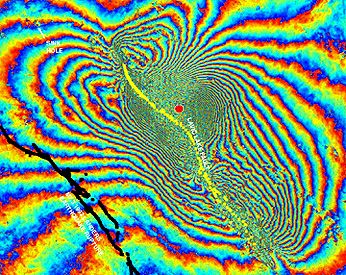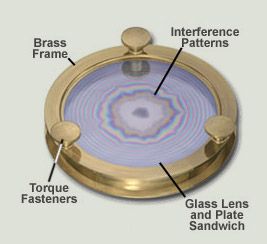A page from the "Causes of Color" exhibit...
Practical applications of interference effects


Interferometry, a type of photoelastic stress analysis, is used for large-scale investigations. This interferogram shows displacement strain from an analysis of satellite data soon after an earthquake.
Photoelastic stress analysis
Lasers, LED’s, and advanced digital analysis have spurred the development of photoelastic stress analysis, which produces interference fringe patterns that uncover the effects of strains and stresses on glass, machinery, and other objects.
In photoelastic stress analysis, a reflective coating is applied to the surface of the object under investigation, and a tool such as a digital polariscope splits coherent, monochromatic light into two beams and shines them on the object through a system of polarizers. The resulting interference fringe patterns change when stress is applied to the object.
Dentists use this technique to gauge the stress points of an orthodontic bridge when fitted in different ways, while in medicine an accurate latex model of an aneurism in the heart allows scientists to gain a better understanding of the stresses involved. For researchers in a variety of scientific fields, photoelastic stress analysis can support or undermine hypotheses developed using mathematical models.

When two transparent surfaces meet with a very thin tapered gap between them, a special case of interference occurs. Monochromatic light interference creates a series of dark and light bands. Using incident white light, the sequence of overlapping light and dark bands from the spectral colors leads to a phenomenon known as "Newton’s colors."
Newton rings
When light waves bounce off a reflective surface, they "flip over" - the reflected wave has a crest where the incident wave had a trough, and vice versa. This happens because glass has a higher refractive index than air, meaning that light travels more slowly in glass than in air. This flip means that the incident wave and reflected wave are out of phase. This causes some interesting interference effects, especially when two reflective surfaces are placed very close together, for instance in a double pane of glass. Newton rings are a special example of this interference that occurs when the gap tapers down to nothing.
Newton’s colors are seen in the tapered air gap between touching non-flat sheets of glass, in cracks in glass or in crystals, in a soap bubble, in an oil slick on a water surface, and in the petrological microscope.
Antireflection coatings, as on camera lenses, employ this effect. A coating that has a refractive index between those of glass and air, and a thickness of one quarter the wavelength of light, can reduce the overall reflected light to less than one half. Multiple layers can reduce this reflection to less than one tenth, and usually appear purple to the eye.



